| Listing 11 - 20 of 20 | << page >> |
Sort by
|

ISBN: 0122062205 9780122062209 Year: 1981 Publisher: London Academic press
Abstract | Keywords | Export | Availability | Bookmark
 Loading...
Loading...Choose an application
- Reference Manager
- EndNote
- RefWorks (Direct export to RefWorks)
Visual Perception --- Memory --- Face --- Face perception --- Face. --- Memory. --- Visual Perception. --- 159.93 --- 159.95 --- Face recognition (Psychology) --- Facial perception --- Facial recognition (Psychology) --- Recognition, Facial (Psychology) --- Visual perception --- Executive Function --- Faces --- Perception, Visual --- Perceptions, Visual --- Visual Perceptions --- Vision, Ocular --- Zintuiglijke waarnemingen --- Geestelijke functies --- 159.95 Geestelijke functies --- 159.93 Zintuiglijke waarnemingen --- Visual Processing --- Processing, Visual
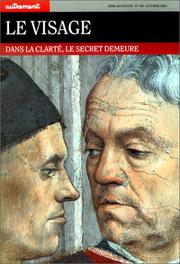
ISBN: 2862604747 9782862604749 Year: 1994 Volume: 148 Publisher: Paris Editions Autrement
Abstract | Keywords | Export | Availability | Bookmark
 Loading...
Loading...Choose an application
- Reference Manager
- EndNote
- RefWorks (Direct export to RefWorks)
Tout entier dans ce qu'il donne à voir, le visage croit ainsi se protéger de l'imprévisible, incapable d'admettre qu'il faut vivre avec soi-même et avec autrui sur le fond invisible du secret qui rend chacun singulier et irremplaçable. Cependant, la condition humaine ne s'éprouve pas seulement dans le face-à-face, mais aussi dans la vie sociale. Comment une société démocratique, fondée sur des institutions vouées à veiller au bien et à l'égalité de tous, peut-elle faire place à la singularité du visage ?
Face perception --- Face --- Facial expression. --- 7.041 --- CDL --- Facial expressions --- Body language --- Expression --- Human face --- Head --- Pathognomy --- Physiognomy --- Face recognition (Psychology) --- Facial perception --- Facial recognition (Psychology) --- Recognition, Facial (Psychology) --- Visual perception --- Social aspects. --- Psychological aspects. --- Facial expression --- Social aspects --- Psychological aspects --- Visage --- Physionomies --- Esthetique comparee --- Physiognomonie
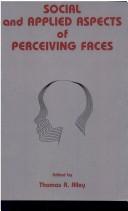
ISBN: 0805801634 Year: 1988 Publisher: Hillsdale Erlbaum
Abstract | Keywords | Export | Availability | Bookmark
 Loading...
Loading...Choose an application
- Reference Manager
- EndNote
- RefWorks (Direct export to RefWorks)
Face. --- Facial Expression. --- Psychology, Social. --- Social Perception. --- Visual Perception. --- 159.931 --- 316.473 --- Face perception --- -#SBIB:309H53 --- Face recognition (Psychology) --- Facial perception --- Facial recognition (Psychology) --- Recognition, Facial (Psychology) --- Visual perception --- Perception, Visual --- Perceptions, Visual --- Visual Perceptions --- Vision, Ocular --- Perception, Social --- Perceptions, Social --- Social Perceptions --- Social Psychology --- Psychologies, Social --- Social Psychologies --- Expression, Facial --- Expressions, Facial --- Facial Expressions --- Physiognomy --- Faces --- Zien. --- Sociale waarneming. Beoordeling van medemensen. Egotisme. Attributietheorie sociale perceptie, waarneming --- Social aspects --- Niet-verbale communicatie --- 316.473 Sociale waarneming. Beoordeling van medemensen. Egotisme. Attributietheorie sociale perceptie, waarneming --- 159.931 Zien. --- -Face recognition (Psychology) --- Face --- Facial Expression --- Psychology, Social --- Social Perception --- Visual Perception --- Zien --- Psychology, Perceptual --- Perceptual Psychology --- Visual Processing --- Processing, Visual --- Face Expression --- Expression, Face --- Face Expressions
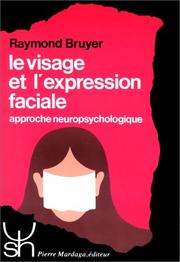
ISBN: 2870091753 9782870091753 Year: 1983 Volume: 118 Publisher: Bruxelles Liège Pierre Mardaga
Abstract | Keywords | Export | Availability | Bookmark
 Loading...
Loading...Choose an application
- Reference Manager
- EndNote
- RefWorks (Direct export to RefWorks)
Le visage et l'expression faciale constituent des objets extrêmement fréquents de l'environnement de chacun de nous, et sont d'une importance déterminante pour toute relation interpersonnelle. Curieusement, c'est seulement depuis une quinzaine d'années que ces "stimuli" font l'objet de recherches, très nombreuses, en psychologie expérimentale ; ce "retard" tient sans doute à la complexité de l'objet sous analyse et à de considérables difficultés méthodologiques. Depuis plusieurs années, l'auteur étudie ces processus sous l'angle de la neuropsychologie. Il présente ici une synthèse des connaissances scientifiques actuelles en cette matière, en marquant cependant sans équivoque son intérêt personnel pour une approche neuropsychologique. L'ouvrage, sans équivalent actuel, s'adresse donc en premier lieu aux neuropsychologues qui s'intéressent à la perception du visage et de l'expression faciale. Abordant également la pathologie neurologique tout autant que les travaux de psychologie expérimentale, il devrait de surcroît intéresser tant les neurologues que les spécialistes en psychologie expérimentale de la perception et la communication non verbale. Il vise ensuite tous les professionnels de la psychologie, impliqués dans des relations en "face à face". Il devrait enfin concerner tous ceux qui sont préoccupés de relations interpersonnelles, de manière professionnelle ou occasionnelle. Cette revue très documentée aborde également certains faits relevant de la psychiatrie.
Neurologie --- Psychologie --- Face perception --- Facial expression --- Emotions --- Neuropsychology --- Perception des visages --- Expression du visage --- Neuropsychologie --- Facial Expression --- Facial Expression. --- Neurophysiology --- Psychophysiology --- Feelings --- Human emotions --- Passions --- Psychology --- Affect (Psychology) --- Affective neuroscience --- Apathy --- Pathognomy --- Face --- Facial expressions --- Body language --- Expression --- Expression, Facial --- Expressions, Facial --- Facial Expressions --- Physiognomy --- Emotions. --- Face perception. --- Facial expression. --- Neuropsychology. --- Face recognition (Psychology) --- Facial perception --- Facial recognition (Psychology) --- Recognition, Facial (Psychology) --- Visual perception --- Face Expression --- Expression, Face --- Face Expressions --- Visage
Book
ISBN: 3642407838 3642407846 Year: 2014 Publisher: Heidelberg, Germany : Springer,
Abstract | Keywords | Export | Availability | Bookmark
 Loading...
Loading...Choose an application
- Reference Manager
- EndNote
- RefWorks (Direct export to RefWorks)
This book provides readers with a simplified and comprehensive account of the cognitive and neural bases of face perception in humans. Faces are ubiquitous in our environment and we rely on them during social interactions. The human face processing system allows us to extract information about the identity, gender, age, mood, race, attractiveness and approachability of other people in about a fraction of a second, just by glancing at their faces. By introducing readers to the most relevant research on face recognition, this book seeks to answer the questions: “Why are humans so fast at recognizing faces?”, “Why are humans so efficient at recognizing faces?”, “Do faces represent a particular category for the human visual system?”, What makes face perception in humans so special?, “Can our face recognition system fail”? This book presents the author’s findings on face perception during his research studies on both normal subjects and subjects with prosopagnosia, a neurological disorder characterized by the inability to recognize faces. The book describes two known forms of prosopagnosia: acquired prosopagnosia, which is the result of a brain lesion, and congenital prosopagnosia, which refers to a lifelong, developmental impairment of face recognition. Written in a comprehensive and accessible style, this book addresses both experts (cognitive scientists, psychologists, neuroscientists and computer scientists) and the general public, and aims at raising awareness for a debilitating face recognition disorder, such as prosopagnosia, which is often ignored or misdiagnosed as autism, with serious consequences for the affected persons and their families.
Face perception. --- Prosopagnosia. --- Face recognition (Psychology) --- Facial perception --- Facial recognition (Psychology) --- Recognition, Facial (Psychology) --- Popular works. --- Neurosciences. --- Artificial intelligence. --- Psychology. --- Popular Science. --- Popular Science in Psychology. --- Artificial Intelligence (incl. Robotics). --- Behavioral sciences --- Mental philosophy --- Mind --- Science, Mental --- Human biology --- Philosophy --- Soul --- Mental health --- AI (Artificial intelligence) --- Artificial thinking --- Electronic brains --- Intellectronics --- Intelligence, Artificial --- Intelligent machines --- Machine intelligence --- Thinking, Artificial --- Bionics --- Cognitive science --- Digital computer simulation --- Electronic data processing --- Logic machines --- Machine theory --- Self-organizing systems --- Simulation methods --- Fifth generation computers --- Neural computers --- Neural sciences --- Neurological sciences --- Neuroscience --- Medical sciences --- Nervous system --- Agnosia --- Face perception --- Visual perception --- Artificial Intelligence.
Book
ISBN: 3839448468 383764846X Year: 2019 Publisher: Bielefeld
Abstract | Keywords | Export | Availability | Bookmark
 Loading...
Loading...Choose an application
- Reference Manager
- EndNote
- RefWorks (Direct export to RefWorks)
Automated facial recognition algorithms are increasingly intervening in society. This book offers a unique analysis of these algorithms from a critical visual culture studies perspective. The first part of this study examines the example of an early facial recognition algorithm called »eigenface« and traces a history of the merging of statistics and vision. The second part addresses contemporary artistic engagements with facial recognition technology in the work of Thomas Ruff, Zach Blas, and Trevor Paglen. This book argues that we must take a closer look at the technology of automated facial recognition and claims that its forms of representation are embedded with visual politics. Even more significantly, this technology is redefining what it means to see and be seen in the contemporary world. »Durch die produktive Verschränkung von sozial-, medien- und kunstwissenschaftlichen Diskursen gelingt es der Autorin die Problematik der automatischen Gesichtserkennung in seiner vollen Breite, wie in seiner sozio-historischen Genese deutlich werden zu lassen.« Florian Flömer, www.surveillance-studies.org, 29.01.2020
Media studies --- Communication. Mass media. --- SOCIAL SCIENCE / Media Studies. --- Image. --- Media Aesthetics. --- Media Art. --- Media Studies. --- Photography. --- Technology. --- Visual Studies. --- Visual Culture; Machine Vision; Facial Recognition Technology; Biometrics; Art; Technology; Image; Media Aesthetics; Visual Studies; Media Art; Photography; Media Studies --- Face perception. --- Human face recognition (Computer science) --- Portraits. --- Portraiture --- Art --- Biography --- Pictures --- Face recognition, Human (Computer science) --- Facial pattern recognition (Computer science) --- Optical pattern recognition --- Face recognition (Psychology) --- Facial perception --- Facial recognition (Psychology) --- Recognition, Facial (Psychology) --- Visual perception --- Visual Culture --- Machine Vision --- Facial Recognition Technology --- Biometrics --- Technology --- Image --- Media Aesthetics --- Visual Studies --- Media Art --- Photography --- Media Studies
Book
ISBN: 3030153819 3030153800 Year: 2019 Publisher: Cham : Springer International Publishing : Imprint: Springer,
Abstract | Keywords | Export | Availability | Bookmark
 Loading...
Loading...Choose an application
- Reference Manager
- EndNote
- RefWorks (Direct export to RefWorks)
In this book, the authors discuss the recent developments in computational techniques for automated non-invasive facial emotion detection and analysis with particular focus on the smile. By way of applications, they discuss how genuine and non-genuine smiles can be inferred, how gender is encoded in a smile and how it is possible to use the dynamics of a smile itself as a biometric feature. It is often said that the face is a window to the soul. Bearing a metaphor of this nature in mind, one might find it intriguing to understand, if any, how the physical, behavioural as well as emotional characteristics of a person could be decoded from the face itself. With the increasing deductive power of machine learning techniques, it is becoming plausible to address such questions through the development of appropriate computational frameworks. Though there are as many as over twenty five categories of emotions one could express, regardless of the ethnicity, gender or social class, across humanity, there exist six common emotions – namely happiness, sadness, surprise, fear, anger and disgust - all of which can be inferred from facial expressions. Of these facial expressions, the smile is the most prominent in social interactions. The smile bears important ramifications with beliefs such as it makes one more attractive, less stressful in upsetting situations and employers tending to promote people who smile often. Even pockets of scientific research appear to be forthcoming to validate such beliefs and claims, e.g. the smile intensity observed in photographs positively correlates with longevity, the ability to win a fight and whether a couple would stay married. Thus, it appears that many important personality traits are encoded in the smile itself. Therefore, the deployment of computer based algorithms for studying the human smiles in greater detail is a plausible avenue for which the authors have dedicated the discussions in this book. .
Human face recognition (Computer science) --- Face perception --- Data processing. --- Face recognition (Psychology) --- Facial perception --- Facial recognition (Psychology) --- Recognition, Facial (Psychology) --- Visual perception --- Face recognition, Human (Computer science) --- Facial pattern recognition (Computer science) --- Optical pattern recognition --- Biometrics. --- Artificial intelligence. --- Algorithms. --- Biology --- Artificial Intelligence. --- Computer Appl. in Life Sciences. --- Biometry. --- Algorism --- Algebra --- Arithmetic --- AI (Artificial intelligence) --- Artificial thinking --- Electronic brains --- Intellectronics --- Intelligence, Artificial --- Intelligent machines --- Machine intelligence --- Thinking, Artificial --- Bionics --- Cognitive science --- Digital computer simulation --- Electronic data processing --- Logic machines --- Machine theory --- Self-organizing systems --- Simulation methods --- Fifth generation computers --- Neural computers --- Foundations --- Biological statistics --- Biometrics (Biology) --- Biostatistics --- Biomathematics --- Statistics --- Statistical methods --- Biometrics (Biology). --- Bioinformatics . --- Computational biology . --- Bioinformatics --- Bio-informatics --- Biological informatics --- Information science --- Computational biology --- Systems biology --- Data processing
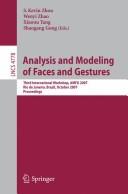
ISBN: 9783540756897 3540756892 3540756906 Year: 2007 Publisher: Berlin, Germany : Springer,
Abstract | Keywords | Export | Availability | Bookmark
 Loading...
Loading...Choose an application
- Reference Manager
- EndNote
- RefWorks (Direct export to RefWorks)
The 2007 IEEE International Workshop on Analysis and Modeling of Faces and Gestures(AMFG)isthethirdworkshopofitstypeorganizedinconjunctionwith ICCV, this time in Rio de Janeiro, Brazil. Our primary goal is to bring together researchersand research groupsto review the status of recognition, analysis and modeling of face, gesture, activity, and behavior; to discuss the challenges that we are facing; and to explore future directions. This year we received 55 submissions. Each paper was reviewed by three program committee members. The whole reviewing process was double blind. However,due to size limit, we were only able to accommodate 22 papers, among which 8 are orals and 14 are posters. The topics covered by these accepted papers include feature representation, 3D face, robust recognition under pose and illumination variations,video-basedface recognition,learning,facial motion analysis, body pose estimation, and sign recognition. A special word of thanks goes to Dr. Feng Zhao, our organizing chair, for his dedication and great e?orts in maintaining both the online submission system and workshop website and in handling most of the author contacts. We are indebted to the advisory committee members for their valuable suggestions and to the program committee members for their hard work and timely reviews. Finally, we thank Cognitec System GmbH and Siemens Corporate Research for their sponsorship. October 2007 S. Kevin Zhou Wen-Yi Zhao Xiaoou Tang Shaogang Gong Organization AMFG 2007 was held in conjunction with ICCV 2007. Workshop Chairs S. Kevin Zhou Siemens Corporate Research Wen-Yi Zhao Intuitive Surgical, Inc.
Optical pattern recognition --- Human face recognition (Computer science) --- Face perception --- Gesture --- Image processing --- Computer software --- Reconnaissance optique des formes (Informatique) --- Reconnaissance des visages (Informatique) --- Perception des visages --- Gestes --- Traitement d'images --- Logiciels --- Congresses. --- Computer simulation --- Digital techniques --- Human factors --- Congrès --- Simulation par ordinateur --- Techniques numériques --- Facteurs humains --- Congresses --- Computer Science --- Electrical Engineering --- Applied Physics --- Engineering & Applied Sciences --- Electrical & Computer Engineering --- Mudra --- Face recognition (Psychology) --- Facial perception --- Facial recognition (Psychology) --- Recognition, Facial (Psychology) --- Computer science. --- Algorithms. --- Artificial intelligence. --- Computer graphics. --- Image processing. --- Pattern recognition. --- Computer Science. --- Pattern Recognition. --- Image Processing and Computer Vision. --- Artificial Intelligence (incl. Robotics). --- Computer Graphics. --- Algorithm Analysis and Problem Complexity. --- Design perception --- Pattern recognition --- Form perception --- Perception --- Figure-ground perception --- Pictorial data processing --- Picture processing --- Processing, Image --- Imaging systems --- Optical data processing --- Automatic drafting --- Graphic data processing --- Graphics, Computer --- Computer art --- Graphic arts --- Electronic data processing --- Engineering graphics --- AI (Artificial intelligence) --- Artificial thinking --- Electronic brains --- Intellectronics --- Intelligence, Artificial --- Intelligent machines --- Machine intelligence --- Thinking, Artificial --- Bionics --- Cognitive science --- Digital computer simulation --- Logic machines --- Machine theory --- Self-organizing systems --- Simulation methods --- Fifth generation computers --- Neural computers --- Algorism --- Algebra --- Arithmetic --- Informatics --- Science --- Foundations --- Optical pattern recognition. --- Computer vision. --- Computer software. --- Artificial Intelligence. --- Software, Computer --- Computer systems --- Machine vision --- Vision, Computer --- Artificial intelligence --- Pattern recognition systems --- Pattern perception --- Perceptrons --- Visual discrimination --- Optical data processing. --- Optical computing --- Visual data processing --- Integrated optics --- Photonics --- Computers --- Optical equipment
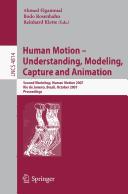
ISBN: 9783540757023 3540757023 3540757031 Year: 2007 Publisher: Berlin : Springer,
Abstract | Keywords | Export | Availability | Bookmark
 Loading...
Loading...Choose an application
- Reference Manager
- EndNote
- RefWorks (Direct export to RefWorks)
This LNCS volume contains the papers presented at the second Workshop on Human Motion Understanding, Modeling, Capture and Animation, which took place on October 20th, 2007, accompanying the 11th IEEE International C- ference on Computer Vision in Rio de Janeiro, Brazil. In total, 38 papers were submitted to this workshop,of which 22 papers were accepted. We were careful to ensure a high standard of quality when selecting the papers. All submissions were double-blind reviewed by at least two experts. Out of the 22 accepted papers, 10 were selected for oral presentation and 12 for posters. We thank the authors of the accepted papers for taking the reviewers’ comments into account in the ?nal published versions of their papers. We thank all of the authors who submitted their work, and we trust that the reviewers’ comments have been of value for their research activities. The accepted papers re?ect the state of the art in the ?eld and cover various topicsrelatedto humanmotiontrackingandanalysis.Thepapersinthisvolume have been classi?ed into three categories based on the topics they cover: human motion capture and pose estimation, body and limb tracking and segmentation, and activity recognition.
Optical pattern recognition --- Kinesiology --- Face perception --- Biometric identification --- Reconnaissance optique des formes (Informatique) --- Cinésiologie --- Perception des visages --- Identification biométrique --- Congresses. --- Congrès --- Movement --- Biometry --- Computer Simulation --- Video Recording --- Musculoskeletal Physiological Processes --- Copying Processes --- Computing Methodologies --- Statistics as Topic --- Epidemiologic Measurements --- Physiological Processes --- Information Science --- Musculoskeletal Physiological Phenomena --- Public Health --- Physiological Phenomena --- Epidemiologic Methods --- Musculoskeletal and Neural Physiological Phenomena --- Phenomena and Processes --- Investigative Techniques --- Environment and Public Health --- Analytical, Diagnostic and Therapeutic Techniques and Equipment --- Health Care --- Physiology --- Applied Physics --- Computer Science --- Engineering & Applied Sciences --- Human Anatomy & Physiology --- Health & Biological Sciences --- Human locomotion --- Analysis --- Data processing --- Face recognition (Psychology) --- Facial perception --- Facial recognition (Psychology) --- Recognition, Facial (Psychology) --- Computer science. --- Artificial intelligence. --- Computer simulation. --- Image processing. --- Biometrics (Biology). --- Bioinformatics. --- Computer Science. --- Image Processing and Computer Vision. --- Simulation and Modeling. --- Artificial Intelligence (incl. Robotics). --- Computational Biology/Bioinformatics. --- Biometrics. --- Bio-informatics --- Biological informatics --- Biology --- Information science --- Computational biology --- Systems biology --- Biological statistics --- Biometrics (Biology) --- Biostatistics --- Biomathematics --- Statistics --- Pictorial data processing --- Picture processing --- Processing, Image --- Imaging systems --- Optical data processing --- Computer modeling --- Computer models --- Modeling, Computer --- Models, Computer --- Simulation, Computer --- Electromechanical analogies --- Mathematical models --- Simulation methods --- Model-integrated computing --- AI (Artificial intelligence) --- Artificial thinking --- Electronic brains --- Intellectronics --- Intelligence, Artificial --- Intelligent machines --- Machine intelligence --- Thinking, Artificial --- Bionics --- Cognitive science --- Digital computer simulation --- Electronic data processing --- Logic machines --- Machine theory --- Self-organizing systems --- Fifth generation computers --- Neural computers --- Informatics --- Science --- Statistical methods --- Human mechanics --- Locomotion --- Visual perception --- Computer vision. --- Artificial Intelligence. --- Machine vision --- Vision, Computer --- Artificial intelligence --- Image processing --- Pattern recognition systems --- Optical data processing. --- Optical computing --- Visual data processing --- Integrated optics --- Photonics --- Computers --- Optical equipment
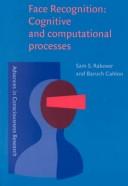
ISSN: 1381589X ISBN: 1282162667 9786612162664 9027298394 9789027298393 9789027251510 9027251517 9781588110510 1588110516 9027251517 1588110516 Year: 2001 Volume: 31 Publisher: Philadelphia, Pennsylvania : John Benjamins Publishing Company,
Abstract | Keywords | Export | Availability | Bookmark
 Loading...
Loading...Choose an application
- Reference Manager
- EndNote
- RefWorks (Direct export to RefWorks)
PSYCHOLOGY --- Cognitive Psychology & Cognition --- Face perception --- Pattern Recognition, Visual --- Face --- Cognitive Science --- Models, Psychological --- Models, Theoretical --- Form Perception --- Visual Perception --- Pattern Recognition, Physiological --- Psychology --- Head --- Behavioral Sciences --- Perception --- Investigative Techniques --- Space Perception --- Body Regions --- Mental Processes --- Behavioral Disciplines and Activities --- Analytical, Diagnostic and Therapeutic Techniques and Equipment --- Anatomy --- Psychological Phenomena and Processes --- Psychiatry and Psychology --- Social Sciences --- Human Information Processing --- Information Processing, Human --- Body Region --- Region, Body --- Regions, Body --- Perception, Space --- Perceptions, Space --- Space Perceptions --- Spatial Learning --- Investigative Technics --- Investigative Technic --- Investigative Technique --- Technic, Investigative --- Technics, Investigative --- Technique, Investigative --- Techniques, Investigative --- Sensory Processing --- Processing, Sensory --- Sensation --- Proxemics --- Behavioral Science --- Proxemic --- Science, Behavioral --- Sciences, Behavioral --- Heads --- Factors, Psychological --- Psychological Factors --- Psychological Side Effects --- Psychologists --- Psychosocial Factors --- Side Effects, Psychological --- Factor, Psychological --- Factor, Psychosocial --- Factors, Psychosocial --- Psychological Factor --- Psychological Side Effect --- Psychologist --- Psychosocial Factor --- Side Effect, Psychological --- Pattern Recognition, Auditory --- Pattern Recognition, Tactile --- Auditory Pattern Recognition --- Physiological Pattern Recognition --- Recognition, Auditory Pattern --- Recognition, Physiological Pattern --- Recognition, Tactile Pattern --- Tactile Pattern Recognition --- Visual Processing --- Perception, Visual --- Processing, Visual --- Vision, Ocular --- Contour Perception --- Contour Perceptions --- Form Perceptions --- Perception, Contour --- Perception, Form --- Perceptions, Contour --- Perceptions, Form --- Contrast Sensitivity --- Experimental Model --- Experimental Models --- Mathematical Model --- Model, Experimental --- Models (Theoretical) --- Models, Experimental --- Models, Theoretic --- Theoretical Study --- Mathematical Models --- Model (Theoretical) --- Model, Mathematical --- Model, Theoretical --- Models, Mathematical --- Studies, Theoretical --- Study, Theoretical --- Theoretical Model --- Theoretical Models --- Theoretical Studies --- Computer Simulation --- Systems Theory --- Model, Mental --- Model, Psychological --- Models, Mental --- Models, Psychologic --- Psychological Models --- Mental Model --- Mental Models --- Model, Psychologic --- Psychologic Model --- Psychologic Models --- Psychological Model --- Cognitive Sciences --- Science, Cognitive --- Sciences, Cognitive --- Faces --- Recognition, Visual Pattern --- Visual Pattern Recognition --- Face recognition (Psychology) --- Facial perception --- Facial recognition (Psychology) --- Recognition, Facial (Psychology) --- Visual perception --- Psychologic Processes --- Psychologic Processes and Principles --- Psychological Processes --- Phenomena, Psychological --- Processes, Psychologic --- Processes, Psychological --- Psychological Phenomenas --- Psychological Processe --- Anatomies
| Listing 11 - 20 of 20 | << page >> |
Sort by
|

 Search
Search Feedback
Feedback About
About Help
Help News
News